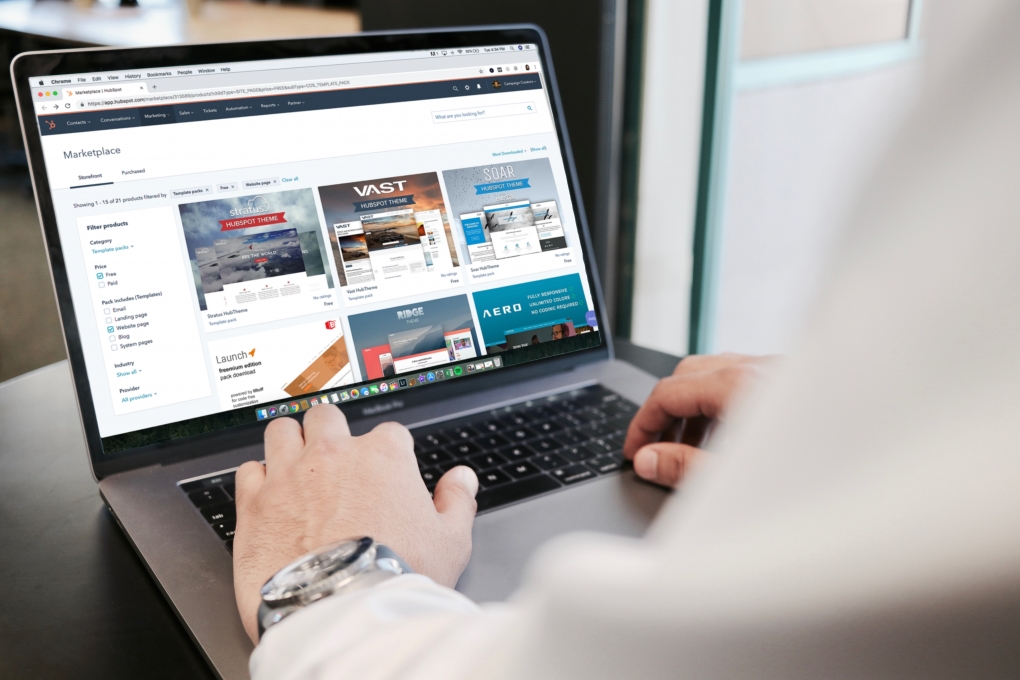What is a Landing Page? Everything you need to know
Landing pages play a huge role when it comes to online marketing and running an eCommerce business. They are used for capturing any kind of leads which is essential for online sales. Also, you can implement landing pages for blogs, webinars, and podcasts. They will help you to increase your conversion rate and make it cheaper to capture leads.
Statistics show that 67% of medium-sized companies utilize landing pages for lead generation all the time. In addition, it has been assessed that companies which make more than 30 landing pages acquire 7 times more leads than those that create less than 10. This shows that landing pages are very valuable and you should definitely consider implementing them.
What is a Landing Page? The exact definition
You’ll notice the term “landing page” very often so it’s important that you understand what exactly a landing page is. Here is the simple definition to make things clear for you:
Landing page is a standalone web page that is designed to capture leads from an online marketing campaign and get the visitors to take a particular action.
The actions that you would like the visitors of your landing page to take could be of various kinds. For example, you may want them to buy some of your products or services. Or it could be something simpler, such as acquiring their contact information. In that case, your landing page may lead the visitors to fill out a form and insert certain details. This could include their names, email addresses, etc.
What is the goal of a Landing Page?
What makes a landing page so important is the purposefulness behind it. When you put great effort into your marketing, the last thing you would like to happen is to waste it. An effective marketing campaign could bring you lots of traffic, and you must do your best to capitalize on it. This alludes to your conversion rate and directing that traffic to a proper landing page will help you increase it.
Thing is, if you simply direct the visitors to your homepage, they may not know what to do from there. You will leave them with too many options, so they may just give the site a quick look and bounce. However, if you lead them to a landing page, they will know what specific action you want them to take. This will make it easier for them to potentially become one of your customers.

Different kinds of Landing Pages
As mentioned above, landing pages help you to get your visitors to take a certain action. If that action is about purchasing something, this is more demanding and it concerns the bottom of your sales funnel. On the other hand, there are some less demanding actions such as getting your visitors to give contact information. In that case, the landing page concerns the top of your sales funnel.
You need to be clear on what specific action you want your visitors to take. Of course, you can create different landing pages for different purposes. If the desired action is less demanding, this will probably make it more likely for your visitors to take it. Signing up for an email list is an easier decision to make than buying a product. However, you could definitely use landing pages to sell.
How do Landing Pages work?
A typical goal that your landing page may have is to help you convert your visitors into leads. When this is the case, the landing page should provide a win-win scenario for both parties. What this means is that if your visitors give you their contact information, they should also get something in return. In order to achieve this, the landing page should include a quality offer such as a free eBook.
If the visitor finds your offer valuable, they will be converted into a lead by giving you their contact information. They could do this by filling a form which will be included in the landing page. From there, you will be able to spend further marketing efforts on that lead in the future. If you do a good job in this regard, you will make it more likely that your leads reach the bottom of your sales funnel.
The anatomy of a Landing Page
There are several elements that can make your landing pages effective and you need to be aware of them. If you utilize them correctly, this will massively help you with your conversion rate. What follows is an overview of these important elements. Use this list to get familiar with the terms and also, to understand what they mean and how they could be of benefit to you and your business:
- Unique selling proposition (USP) – A short phrase that showcases the uniqueness and quality of what you offer. It should be memorable and designed to capture attention.
- The hero shot – An image used to visually represent the benefits of your offer. This way, your visitors could better imagine what they will be getting if they convert.
- The benefits of your offering – You can include a list of the benefits and features of your offer by using bullet points. This will make it easier on your visitors to quickly get the information they need.
- Social proof/Testimonials – You should provide your visitors with a chance to see that other people have had great experiences with your brand. Your visitors are more likely to convert themselves if they know that others have found your offer valuable.
- Call to action (CTA) – The CTA button is arguably the most important element of a landing page. It’s what your visitors click to accomplish the goal of your landing page. Always make sure the CTA is clear, understandable, and easy to see.
- The offer – The offer is what your visitors can get from you. It should be relevant to their interests, and the part of your sales funnel that they are in. Therefore, the offer could range from educational information to an actual product to buy.
- Headline – A short text designed to grab the attention of your visitors and make them stay longer on your landing page. The headline should stand out and be easily understandable. It needs to spark the interest of your visitors and let them know what they should expect.
- Form – A group of fields that your visitors can fill in with information such as their name, email, phone number, etc. It’s a great way to convert them into leads and to offer them value in exchange. Make sure it’s simple to complete and only ask for relevant information.
- Navigation – The usual advice is that you remove navigation elements from your landing pages. That way, your visitors will be less distracted and they will be able to focus on your offer and CTA. This will increase your conversion rate and allow you to capture more leads.
- Design – It’s important that you make your landing pages colorful and visually appealing. You could do it by using quality images and other aesthetic elements. This could help you to grab the attention of your visitors as long as you don’t make it too jumbled. Also, make sure that your landing pages follow the latest design trends.
- Layout – It’s advisable that your landing pages use the format of a single column that is centered. This should make it more likely that your visitors convert.
- Copy – The written content of your landing pages that supports your CTA and provides your visitors with the information they need. Your copy must be clear and straight to the point. When done right, your copy can encourage your visitors to act on your offer.
- Subtext – A short text that serves as an addition to the headline and is usually placed under it. Using a subtext could further help you to keep the attention of the visitors. Keep it simple and don’t reveal too much information.
- Video – You should consider adding a video to your landing pages which could showcase your products or services in use. This could spark even more interest in your visitors and encourage them to convert. Just make sure the video is of professional quality and implemented correctly.
- Social links – You can use your landing pages as an opportunity to increase your following on social media. Sure, the main idea is to get visitors to convert, but getting more people to your social media profiles could be a great bonus.
- Logo – Your brand is represented by your logo, so it’s only natural that you should include it in your landing pages. It will make it easier on your visitors to recognize your brand and know they’re on the right landing page.
- Contact info – In addition to your logo, you should consider adding your contact info to your landing pages. This will make your landing page look more legitimate. Also, you will show your visitors that you are there to offer help in case they need it.
- Infographics – In cases where you need to showcase data and statistics as part of your landing page, consider using infographics. Charts and graphs make for great visuals that can help your visitors to understand the data more easily.
- Icons – These can be used alongside a text in order to make the content more understandable. Icons are also great for grabbing the attention of the visitors and helping them to quickly get the idea of your landing page.
- Trust badges – Images that suggest your website is legitimate and safe for people to make transactions on it. Trust badges will make your visitors feel more at ease and secure about choosing your brand. The more they trust you, the more likely they convert.

Primary benefits of Landing Pages
By now, you have understood what exactly landing pages are and how they work. This article has offered a clear overview of the main elements of landing pages as well as actual examples. As an addition to all this, let’s take a quick look at the main benefits of using landing pages:
- Pinpoint your message – What’s great about landing pages is that they have a focused message and the visitors can’t miss it. The limited content won’t overwhelm the visitors and they will know exactly how to engage with your brand.
- Improve your credibility – As this article has shown, certain landing pages elements are designed to provide social proof. In combination with the fact that landing pages give a clear idea of the value that your brand offers this will boost your credibility.
- Brand recognition – Landing pages can help you to strengthen the identity of your brand. This is done through consistency in the design and quality of your offers. If your brand is memorable to the visitors, they are more likely to recommend you or convert in the future.
- Get more organic traffic – If you optimize your landing pages in terms of SEO and using proper keywords, this will bring more traffic to your website. However, do keep in mind that you may need to update your content at times in case some changes arise.
- Promotion of new products and services – Whenever you have a new product or service, you will want to market it and share the details about it. Landing pages dedicated to this new offer of yours could be a great way to showcase its features and value.
Conclusion
In conclusion, it could be said that landing pages are extremely valuable when it comes to online marketing, running an eCommerce business, capturing any kinds of leads, as well as blogs, webinars, and podcasts. In this article, we have explained what a landing page is, how a typical landing page looks, what its elements are, and what are some of the main benefits of using a landing page.
Also, the info we presented here should be of help if you want to start creating your own landing pages. We hope that you got inspired, and remember that using our tool DragDropr is an extremely easy way to create landing pages. You could choose from over 100 templates, and you don’t need to possess any coding skills. If you have the right idea, you could easily materialize it with DragDropr.



Leave a Reply
Want to join the discussion?Feel free to contribute!